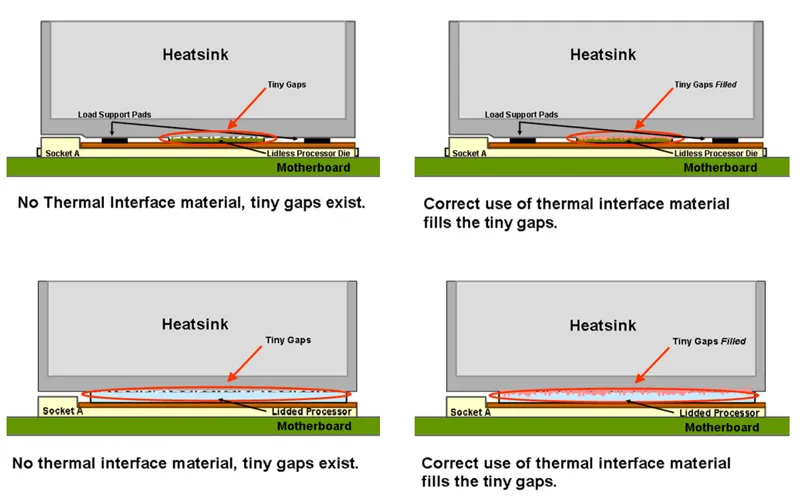Thermal Interface Material Comparison: Thermal Pads vs Thermal Grease
- Posted on:2023-02-10 09:57:00
- Source:AOK Thermal Pad Manufacturer Industry News
In computing and electronics, thermal pads (also called thermally conductive pad or thermal interface pad) are pre-formed rectangles of solid material commonly found on the underside of heatsinks to aid the conduction of heat away from the component being cooled (such as a CPU or another chip) and into the heatsink (usually made from aluminium or copper). Thermal paste (also called thermal compound, thermal grease, thermal interface material (TIM), heat sink compound, heat sink paste or CPU grease) is a thermally conductive (but usually electrically insulating) chemical compound, which is commonly used as an interface between heat sinks and heat sources such as high-power semiconductor devices.
Thermal pads and thermal grease are used to fill air gaps caused by imperfectly flat or smooth surfaces which should be in thermal contact, they would not be needed between perfectly flat and smooth surfaces. Thermal pads are relatively firm at room temperature, but become soft and are able to fill gaps at higher temperatures.
Thermal pads is an alternative to thermal paste to be used as thermal interface material. AMD and Intel have included thermal pads on the bottom of heatsinks shipped with some of their processors, as they are cleaner and generally easier to install. High-performance thermal interface material is needed because even the largest heatsink and fan cannot effectively cool a processor unless there is good physical contact between the base of the heatsink and the top of the processor.
The surfaces of both the heatsink and the processor are not absolutely smooth, because this surface roughness reduces the effective contact area, attaching a heatsink without a thermal interface material is not sufficient due to inadequate surface contact. Between the two nearly flat surfaces. A thermal compound such as phase change material or thermal grease fills these gaps and allows effective heat transference between the processor die and the heatsink.
Two types of thermal interface material (TIM) are commonly used in the electronics industry:
• Thermal pads, also called phase change materials.
• Thermal grease, also called thermal paste.
Phase change materials are usually thin pads approximately 2.5 x 2.5 cm in size and have protective films attached on both surfaces. Thermal grease is similar in consistency to ordinary toothpaste and is typically gray or white.
Five factors affect the choice, use, and performance of the interface material used between the processor and the heatsink:
• Thermal conductivity of the material
• Electrical conductivity of the material
• Spreading characteristics of the material
• Long-term stability and reliability of the material
• Ease of application
Thermal conductivity is the quantified ability of any material to transfer heat. The thermal conductivity of the interface material has a significant impact on its thermal performance. The higher the thermal conductivity, the more efficient the material is at transferring heat. Materials that have a lower thermal conductivity are less efficient at transferring heat, causing a higher temperature differential to exist across the interface. To overcome this less efficient heat transfer, a better thermal management solutions use to achieve the desired heat dissipation.
If you would like to learn more about AOK performance thermal materials, please visit our website at www.aok-technologies.com.


